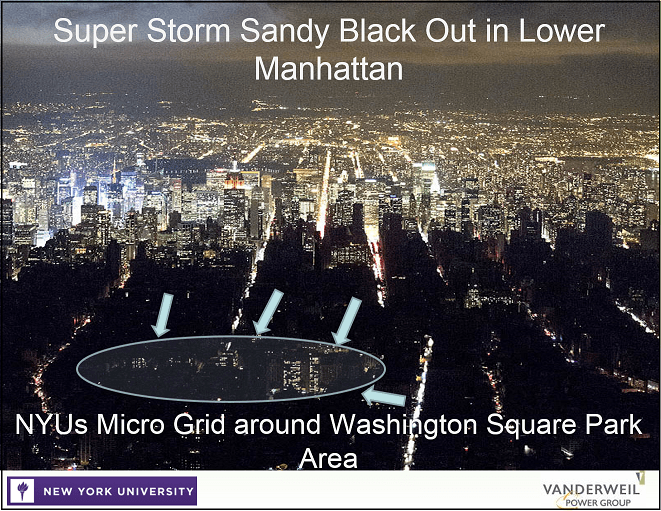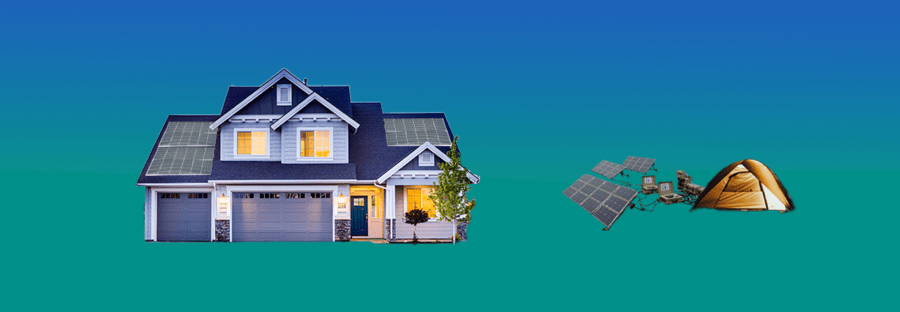Solar microgrids are electricity generators created when batteries are connected to solar panels. They turn the sun’s rays into free, clean, on-demand electricity.
These fantastic tools lower energy bills and cut pollution while expanding electricity access in urban, rural, and uninhabited environments.
To get a better sense of how solar microgrids operate, impact, our lives, and compare with other energy options, let’s explore…
- What solar microgrids are
- How solar microgrids work
- How to identify a solar microgrid
- Why we choose solar microgrids
- Who uses solar microgrids
- Where to get a solar microgrid
What is a solar microgrid?
A solar microgrid is a micro version of the grid that generates electricity from the sun. They’re a type of renewable microgrid because their fuel, sunlight, is renewable and unlimited…at least for the next 5 billion years.
Solar microgrids come in various shapes, sizes, and levels of complexity, but they all have these 3 core components:
- Solar panel(s)
- Battery(s)
- Power control system
The solar panels soak up the sun’s rays and convert the electrons into power you can use. The batteries are the energy reserve. The power control system can enable you to adjust and monitor energy input, electricity output, and the available backup power.

People are rapidly using solar microgrids to cut their reliance on large, centralized grids and carbon-based fuels because solar microgrids can provide cleaner, cheaper, and more reliable power.
Solar microgrids are likely already electrifying buildings, transportation, and activities in your community. Across the globe, they power utility companies, hospitals, schools, prisons, businesses, communities, homeowners, travelers, warfighters, and adventurers.
How does a solar microgrid work?
When the sun’s rays hit a solar microgrid’s solar panels, their energy is collected by the panel’s solar cells and converted into useable electricity or saved in the battery as backup power. The solar microgrid’s operator uses its control system to determine when and how the energy is used.
A solar microgrid’s interconnected energy collection, power storage, and electricity generation capabilities create an electric island. Everyone on the electric island gets reliable and essentially unlimited electricity.
We can attach solar microgrids to a broader power grid and then island when desired, or they can permanently operate as fully independent grids. Either way, you get to keep the lights on regardless of what’s happening in the seas surrounding your electric island.
The scale of solar microgrids’ solar systems varies greatly. Some have solar systems that are only a few watts (W), while others are over 20 kilowatts (kW). The smallest microgrids power small electronics, while the largest can ones serve 100s of households, facilities, and small businesses.
Solar microgrids’ electricity generators
An electricity generator fulfills the microgrid’s core function: turning an energy source into electricity you can use. For solar microgrids, the generators are solar panels. Some solar microgrids have multiple generators; primarily generating electricity with solar panels and using wind turbines or diesel generators to provide additional power.
Solar microgrids’ energy reserves
Having an energy reserve enables microgrids to provide on-demand power. Batteries are solar microgrids’ energy reserves. Typically, solar microgrid batteries store energy using a lead-acid or lithium-ion composition.
Solar microgrids’ power controls
Sophisticated microgrids use software to connect and manage the energy reserve and electricity generator. This enables the solar microgrid’s operator to control the energy input, electricity output, and available backup power. Grid-connected solar microgrids’ software can detect disruptions on the grid and island when needed. Portable solar microgrids, like the ones people carry on backpacking trips, often have much simpler power controls—consisting of a few buttons that turn on and off electrical circuits.
Identifying a solar microgrid
Microgrids vs. solar microgrids
Microgrids are tools that independently store energy and generate electricity. Some are interconnected to the grid, and others operate as fully independent electric islands. Regardless, they’re attractive to people, facilities, and communities for their ability to avoid power outages and reduce peak demand or to electrify areas without access to grid energy.
Since their inception in the 1800s, microgrids have generated electricity using diesel and gas-burning engines. Many of these old-school fossil fuel microgrids still operate today, but in the 21st century, savvy operators are upgrading to renewable microgrids powered by clean energy technologies, like solar panels, wind turbines, hydropower, fuel cells, and heat pumps.
Solar microgrids improve upon traditional fossil-fuel-powered microgrids’ capabilities by generating power with solar panels – providing electricity that’s cleaner, cheaper, and free of fuel stockpiles or pipelines. Solar microgrids are the most widely used type of renewable microgrids.
Within a decade, solar microgrids will be the most used microgrids across the globe.
Solar arrays vs. solar microgrids
Solar panels and solar microgrids are great tools for generating power with the sun’s energy. The panels have photovoltaic cells that collect sunlight and convert it into electricity. Multiple interconnected solar panels are called solar arrays. Solar microgrids are local, independent power grids producing electricity with solar panels.
A solar array with an attached battery and power control system is a solar microgrid. Unlike standalone solar panels or arrays, a solar microgrid unlocks 24-hour electricity access by adding battery storage.
Another advantage unique to a solar microgrid is the power management system’s ability to island the microgrid from a centralized grid’s network. In the event of a natural disaster, power outage, or soaring utility prices, a solar microgrid owner can choose to island and continue affordably having uninterrupted power. Non-islanding electricity generators connected to the grid, like a solar array, shut off when the grid goes down so that they don’t put electricity into wires that utility company workers may need to fix.
After Hurricane Sandy battered the Atlantic coast of the US in 2012, many people with solar panels suffered without electricity for weeks, but those with microgrids, like NYU’s campus in New York City, kept their lights on.

Why do people choose solar microgrids?
Solar microgrids have many benefits. They offer us reliability, flexibility, sustainability, and savings.
Reliable electricity
People increasingly choose solar microgrids to power their lives to can directly control electricity production and have an energy source that’s more reliable than the local grid.
The grid has always experienced power outages, but they’re becoming more frequent as infrastructure ages and the growing climate crisis makes weather more extreme. Solar microgrids are more reliable because they’re autonomous electric islands. On these islands, you store energy, generate electricity, control when and how you use the power, and tap into an unlimited energy source—the sun.
A solar microgrid can island automatically when it detects disruptions in the grid. Ensuring our energy supply is not interrupted by unexpected power outages.
Community solar microgrids electrify grid-connected and off-grid communities. Grid-connected communities use them to achieve greater energy independence and cost savings, and solar microgrids are often the only way for off-grid communities to electrify.
Adopting solar and other renewable microgrids is essential to evolving our energy use to keep up with the changing times. It’s now possible to enhance convenience and equality of life by cutting the cord with unreliable centralized power grids.
Clean energy
Toxic emissions and pollution from burning fossil fuels are concerning for our health today and preserving a liveable planet for the people being born this year. Fortunately, solar microgrids provide free, reliable, and non-polluting electricity. Cleaner and more efficient power systems are critical to protecting us all.
Producing your own power from a local source is more efficient than purchasing it from utility companies because we avoid the energy loss that comes from sending electricity long distances over transmission lines. Plus, most utility companies generate much of their electricity from burning dirty fossil fuels. Adding insult to injury, we exhaust even more energy transporting the fossil fuels from where they are dug up (or cut down) to where we burn them to create electricity. By using a solar microgrid to replace grid electricity, you’re able to productively use more electricity and avoid producing toxic and weather-changing emissions.
By reducing our carbon footprint today with solar microgrids, we make a positive lasting impact on our bodies, communities, and children.
Low-cost power
Most people want to use more energy and save money on energy bills. The good is getting a solar microgrid will likely lower your energy bills, unlock more useable power, and provide peace of mind.
Renewable microgrids produce free electricity by collecting available energy from natural local sources and converting it into electricity. Once you purchase the solar microgrid equipment, the electricity will remain free for as long as our sun is.
A solar microgrid connected to the grid assures predictable, affordable energy bills by limiting your susceptibility to volatile fossil fuel prices and utility companies’ increasing charges. Just island, or better yet, sell your stored excess energy when energy prices are high. You can always switch back to grid power during the utility company’s low-price periods.
Recently, Electric Islands examined how much money a solar microgrid can save homeowners in US states each year, discovering that households in many states save $100s to $1000s annually. Those savings will likely increase yearly due to the steady price decreases for solar microgrid technologies and the increasing cost of grid electricity.
The Clean Coalition’s Community Microgrid Initiative has set out to prove that solar microgrids can provide at least 25% of Puerto Rico’s consumed electricity while maintaining grid reliability and power quality by 2025. This initiative occurred after 2017’s Hurricane Maria knocked out the island’s grid and electricity for months. One of these solar microgrids is in Yabucoa and has provided a lifeline for the town during subsequent grid outages. The microgrid has provided residents with a clean, reliable energy system serving people’s basic needs during outages while generating free electricity.
Solar microgrids reduce air pollution, produce electricity locally, create local jobs, and lower energy bills. Investing in them and other local renewable energy sources secures our energy independence and ensures that your community has reliable, clean, and affordable electricity.
Who uses a solar microgrid?
We use solar microgrids for many reasons, from powering homes, hospitals, schools, and businesses to running irrigation pumps for agriculture, illuminating streetlights, and electricity on the go. Let’s meet a few of today’s solar microgrid users:
Entrepreneurs powering businesses
In Uganda electricity is in short supply. It’s one of the least electrified countries on the planet.
Ben Male, an enterprising Ugandan in the Kampala area, faced a severe dilemma a few years back. He needed money to cover the school fees for seven children, but nearby job opportunities were minimal and low-paid, and his earnings from farming and brick-making weren’t enough to cover the schooling for all of the children.
So, he devised a plan to open gaming centers in nearby off-grid communities. But first, he needed a way to power the centers.
His solution? Set up a solar microgrid at each center powered by a 200-watt solar panel.
Today, he operates 2 gaming centers, is constructing a larger 3rd center with a pool table and bar, and, most importantly, has funds for schooling. Ben’s goal is to eventually run 10 solar microgrid-powered locations.
Facilities keeping the lights on
Facilities of all types are using solar microgrids to ensure operations are uninterrupted.
In 2019, the Shatz Energy Research Center doubled the Blue Lake Rancheria’s solar microgrid battery capacity to 1150kW/1950kWh, serving tribal lands in California’s Humbolt Bay.

The timing was fortuitous. That fall, the local utility company shut off its nearby powerlines to prevent sparking a wildfire, leaving the microgrid to be the sole power source for the area. Its electricity powered the United Indian Health Services, allowing them to keep critical medications refrigerated and save 8 lives. The health center also provided a place for locals to charge their cell phones to follow news updates and inform families.
Homeowners wanting peace of mind
Homeowners across the globe are opting to power their houses with solar microgrids. Freeing themselves from the worries of high electric bills, power outages, and creating air pollution.
John Rettinger, also known as the TechnoBuffalo, has a house in California with a Tesla solar microgrid. John’s solar panels power the home in the morning and charge his EVs’ batteries. At noon, he stops receiving the energy and begins selling it to his utility company, Southern California Edison (SCE). In the evening, he switches back to using solar before the sun sets and then transitions to battery power.
Watch this video to see how having a solar microgrid has changed John’s life.
People on the move
There are portable versions of solar microgrids. Enabling us to create an electric island wherever life takes us.
It’s key for Backcountry-ers like entrepreneur and ecologist Lindsey Davis, to keep her tools and communication devices powered during long off-grid adventures. According to Lindsey, “You never know when you’re going to have to set up camp. By having a way to generate my own power, I’ve found it allows me to stay out longer and truly have a ‘base camp’ I can rely on.”

Where to get a solar microgrid
So now you’re likely asking yourself, how do I get a solar microgrid? The good news is there’s likely a supplier in your area who can sell or lease one to you, but which supplier is the best option will depend on your location and how you plan to use the microgrid.
First, decide if you want the solar microgrid to be portable, power a home, service a business or facility, or electrify a whole community. Then check out the suppliers below to see if they service your area or if your local suppliers offer similar products and services.
Portable solar microgrid
LuminAID and Goal Zero sell portable solar microgrids that are perfect for your backpack, vehicle, or apartment. They range in price from $50-$2.5K. Both companies make high-quality products that I can recommend from personal experience. But if you’re on a tight budget, you can likely find other brands offering reliable portable solar microgrids at a lower price point.
Home solar microgrids
Home solar microgrid options vary substantially based on the region and country where you live. Often, you can buy or lease a solar system, battery, and management software from different manufacturers or service providers and combine them to create a solar microgrid, but it’s often easier to set them up and get a better warranty if you procure them from the same source.
Home solar microgrid prices range from as low as a few thousand dollars to over $50K. It all depends on how much energy you need and the brand(s) you choose. There’s a vast range in the quality and service of components, so it’s vital to do your research.
Enphase, Tesla, and Maxeon (known as SunPower in the US) are some of the most well-known solar microgrid brands worldwide. These and many home solar microgrid companies also offer solar microgrids that power businesses or whole communities.
Community solar microgrids
The bigger the microgrid, the more it needs to be customized for the user(s). Many companies, organizations, and governments focus on installing solar microgrids for whole communities to enhance energy independence, access electricity for the first time, and protect themselves from devastating power outages. Check out Clean Coalition, Ilumexico, ENGIE, and the Rocky Mountain Institute to learn how these organizations support community microgrid development.
Microgrid Knowledge is an excellent resource for discovering who is providing community-level microgrids worldwide.
Asking friends, family, or even energy companies servicing your area about local solar microgrid suppliers is a great way to find available options and maybe even get a referral discount. If they can’t point you toward a company that has what you’re looking for, search online.
Asking friends, family, or even the utility company(s) servicing your area about local solar microgrid suppliers is a great way to find available options and get a referral discount. You can also search online to discover more companies and organizations offering what you want.

